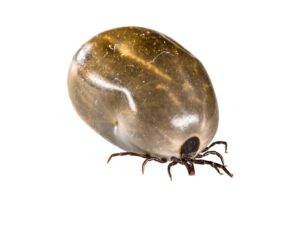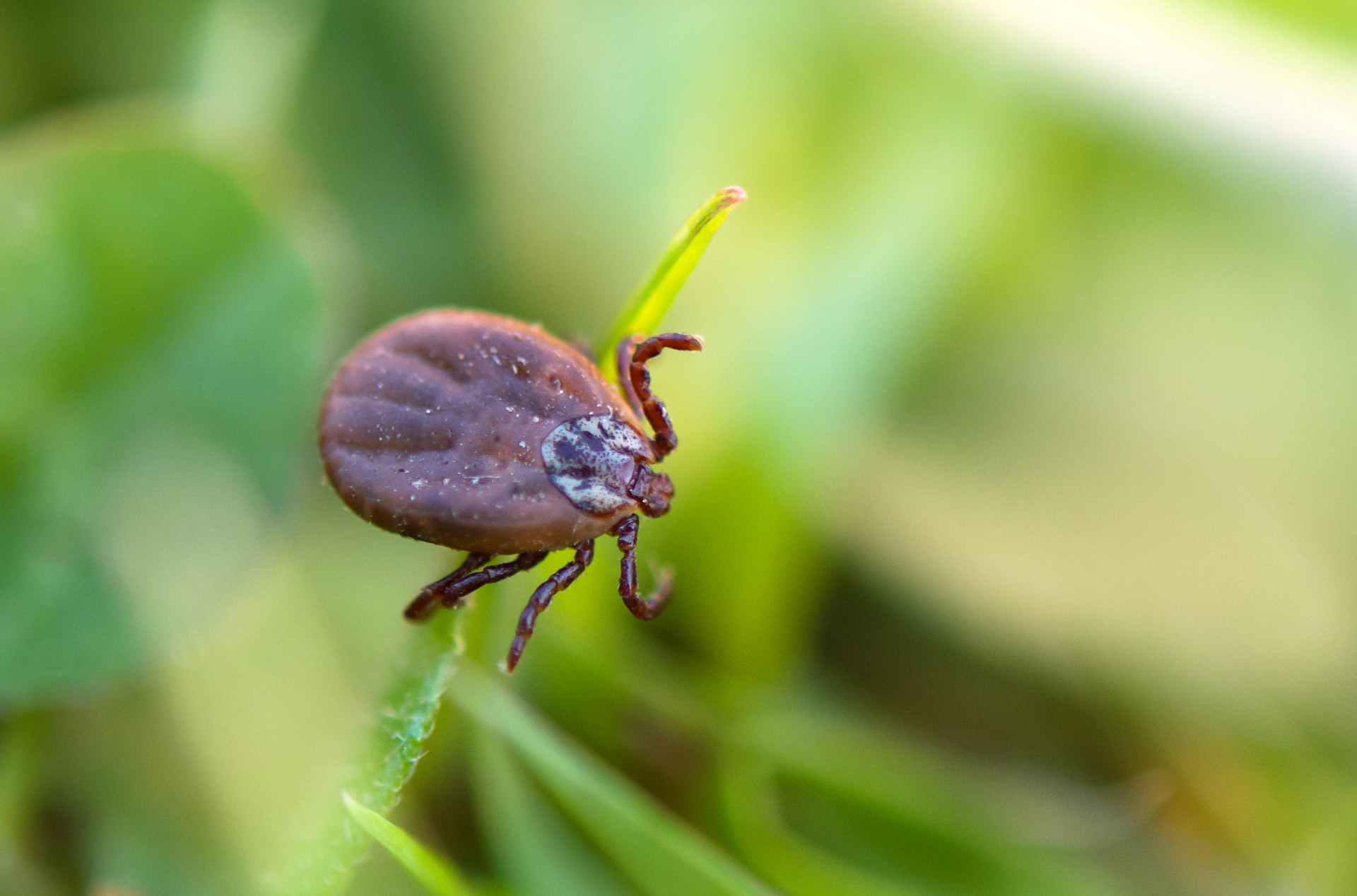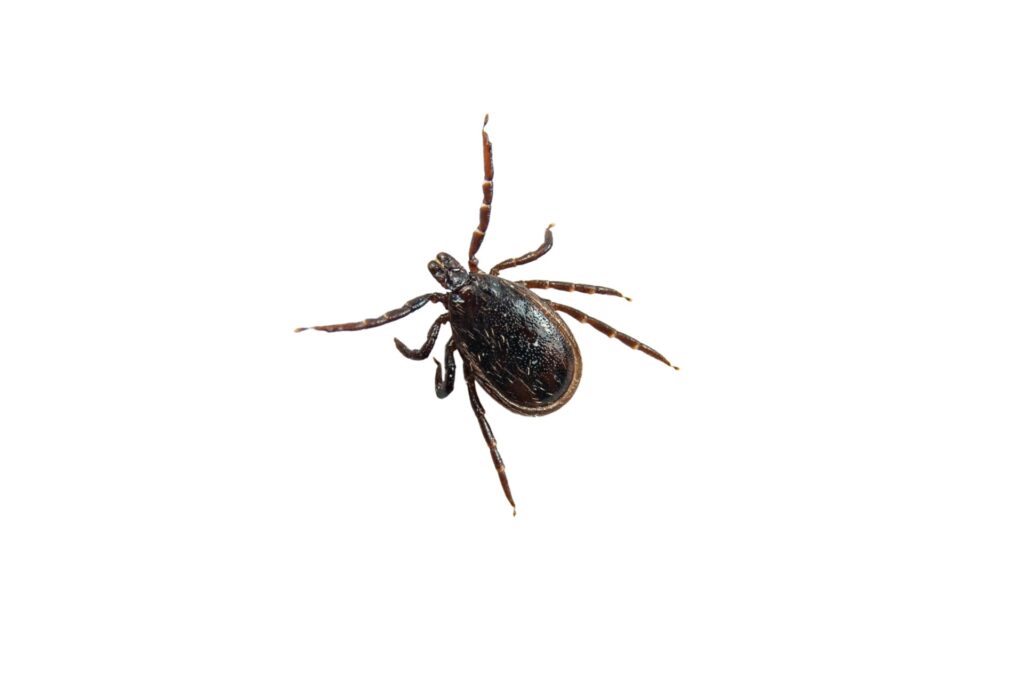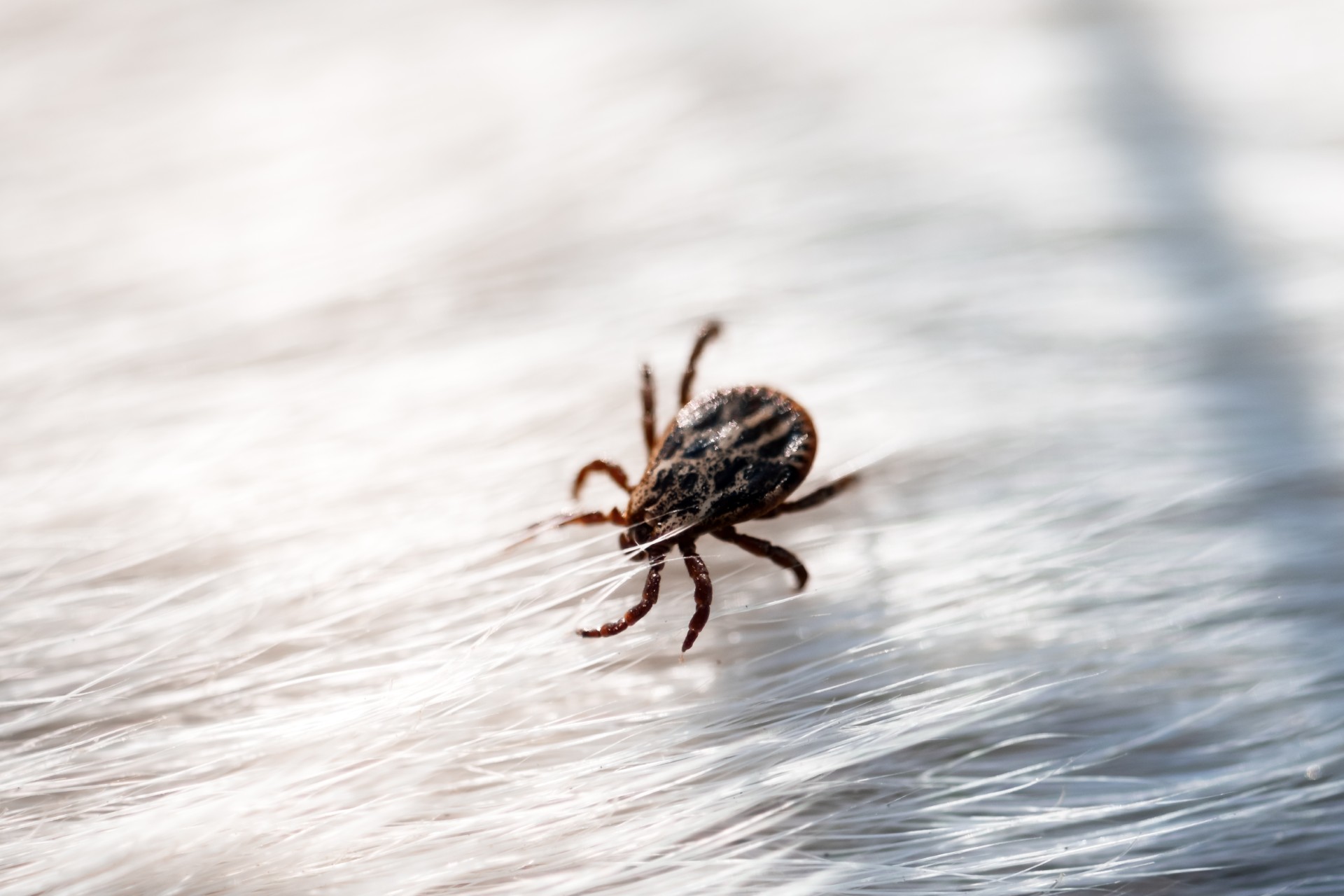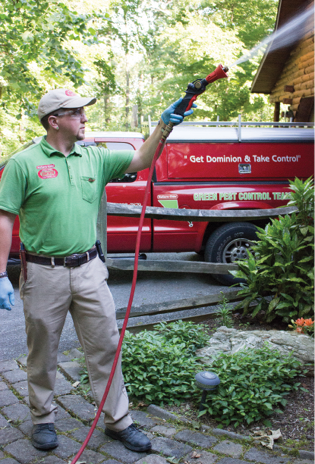How to Tell if You Need Tick Control
Finding a tick on you or your pet can be alarming, especially since ticks carry several harmful disease. So how can you tell if you have ticks? If you frequently find ticks on yourself, pets, or in shaded, overgrown areas of your yard, you may have an infestation. High wildlife activity, humid conditions, and pets constantly scratching or carrying ticks inside are also strong indicators.
A Dominion Pest Control professional tick exterminator will be experienced in diagnosing and treating tick infestations. Depending on your individual situation, our tick control expert can provide you with the most suitable option and ensure that all safety guidelines are followed during the tick control process.
Ticks
What Are the Most Common Types of Ticks Near Me?
Pennsylvania has at least 25 tick species (worldwide, there are more than 900!). Locally, the blacklegged tick and the American dog tick are predominant.
Blacklegged Tick (Deer Tick) – Ixodes scapularis
- Particularly problematic in Lancaster, Berks, Lebanon, Chester, Dauphin, Cumberland, and York counties due to large, forested areas.
- Most common in wooded areas and along hiking trails.
- High risk for Lyme disease, anaplasmosis, and (emerging) babesiosis.
American Dog Tick – Dermacentor variabilis
- Abundant in open fields, roadsides, and agricultural areas.
- Seen frequently in Lancaster, York, Cumberland, and Dauphin counties.
- Carrier of Rocky Mountain spotted fever (RMSF).
Lone Star Tick – Amblyomma americanum
- Expanding rapidly in southeastern PA, including Chester, Lancaster, and York Counties.
- Prefers warm, wooded areas and brushy habitats.
- Can cause Alpha-gal syndrome (red meat allergy) and STARI (a Lyme-like illness)
Groundhog Tick (Woodchuck Tick) – Ixodes cookie
- Often found near dens of skunks, foxes, and groundhogs.
- Present in both rural and suburban areas across Pennsylvania.
- Can carry Powassan virus, although human transmission is rare.
Brown Dog Tick – Rhipicephalus sanguineus
- Primarily found in and around homes and kennels; thrives in indoor environments.
- Uncommon outdoors in PA but can infest homes where dogs live.
- Can transmit diseases such as ehrlichiosis and Rocky Mountain spotted fever to dogs and occasionally humans.
Asian Longhorned Tick – Haemaphysalis longicornis
- Recently detected in south-central PA, including Dauphin and York Counties.
- Mostly affects livestock and pets but has the potential to bite humans.
When Are Ticks Most Active in Pennsylvania?
Understanding seasonal activity is key to protecting yourself, your pets, and your property from tick-borne diseases. Ticks are most active during warmer months, with peak activity and the risk of tick infestation typically occurring from late spring through early fall. However, some species, like the blacklegged (deer) tick, can remain active during mild winters as long as temperatures stay above freezing.
Tick activity can also vary across different regions of Pennsylvania:
Southeastern PA (Lancaster, Berks, Bucks, Chester, Delaware, Montgomery Counties, etc.) – High tick activity due to dense populations, suburban woodlots, and warmer climates. Deer ticks and lone star ticks are common, with peak risk from May through September.
Central PA (Dauphin, York Counties, etc.) – Tick activity is moderate to high, especially in forested areas like Gifford Pinchot State Park or Boyd Big Tree Preserve. The blacklegged tick, a primary vector of Lyme disease, thrives here, with activity beginning as early as April.
Western & Northern PA (Pittsburgh, Erie, the Poconos, etc.) – Cooler, heavily wooded regions see a later start to tick season, typically May through October. American dog ticks and blacklegged ticks are common in rural and recreational areas.
Ticks are most encountered in tall grasses, brush, forest edges, and leaf litter. Even in winter, brief warm spells can trigger activity, especially in adult blacklegged ticks. Regular tick checks after outdoor activities, proper landscaping to reduce tick habitats, and tick control treatments around the home can greatly reduce the risk of bites and help with tick removal. Preventive measures are especially important in areas with high deer and rodent populations, which serve as hosts for many tick species.
Protecting against ticks is a year-round effort, but extra vigilance from April through October can help prevent exposure to Lyme disease and other tick-borne illnesses. Professional tick control services should be part of a property owner’s annual tick removal plan.
Signs of Ticks Infestation:
Just a few tick sightings is not cause for alarm. However, the following 5 signs may mean you have a tick infestation where you live:
- Pets Constantly Scratching or Carrying Ticks Inside – If your dog or cat frequently brings ticks inside or is excessively scratching, your yard might be infested. A closer inspection of pet bedding or resting areas may reveal more ticks.
- Frequent Tick Sightings – If you or your pets regularly find ticks on clothing, skin, or fur after spending time outside, it’s a strong indicator that your yard is hosting them.
- High Rodent or Wildlife Activity – Ticks hitch rides on deer, mice, squirrels, and other wildlife. If you see frequent animal activity, especially near tall grass or wooded areas, ticks are likely present.
How Can I Get Rid of Ticks in my Yard
A tick exterminator may use the following tick control treatments to get rid of ticks in yards.
Professional exterminators like Dominion Pest Control are trained and experienced in treating tick infestations. Depending on your individual situation, we can provide you with the most suitable option and ensure that all safety guidelines are followed during the application process.
Targeted treatments may involve applying pesticides directly onto the ground around your property’s perimeter or into any crevices in walls or fences.
- At Dominion, we offer natural solutions like Nature-Cide® green pest control products. When applied by a skilled professional, commercial grade Nature-Cide® Insecticide targeting fleas and ticks is a powerful remedy. Besides being non-hazardous and non-flammable, Nature-Cide products are made from 100% natural ingredients; these include clove oil, cottonseed oil, cedar oil, and cinnamon oil. The proprietary blends used in Nature-Cide® are a powerful alternative to traditional pest control products. Our natural tick control methods kill ticks and fleas on the spot. What’s more, they also repel other insects like mosquitoes.
- Diatomaceous Earth – You may also want to consider using diatomaceous earth (DE), a naturally occurring substance formed from the fossils of marine algae. DE destroys the waxy outer layer of ticks, causing them to dehydrate. Not only does this abrasive powder help to kill adult ticks, but it also prevents new ones from hatching.
- Heated Insect Traps – Heated insect traps are another nontoxic way to remove ticks from your house. These traps use infrared lights that attract the pests, after which they are captured in a bag or container for easy disposal.
- Chemical Solutions – In addition to natural repellents, there are a variety of chemical solutions available for controlling tick populations. However, we recommend using these products with caution: When it comes to insecticides, improper use can cause more harm than good. Many of these items can also be toxic to children and pets.
Each method depends on the severity of the infestation, location, and type of tick present. Our pest control experts know exactly what type of insecticide to apply and where to apply it. Learn more about the Dangers of Self Treating for Pests.
Common Options We Do Not Recommend

- Overusing broad-spectrum insecticides or spraying the entire lawn – Doing socan kill beneficial insects and pollinators while missing the real tick hotspots (edges of woods, brush piles, and shaded areas.) Professional pest control technicians focus treatment where ticks actually live.
- Relying on Chickens or Guinea Fowl Alone – It’s true that some birds eat ticks, but relying on them alone as a tick control method is unpredictable and insufficient. Their range is limited, and they may not actually target ticks in the densest habitat areas. For homeowners in wooden areas, raising guinea fowl may require zoning permissions.
What are My Next Steps to Prevent Ticks?
Choose peace of mind! If you suspect you have a tick infestation and want to know how to keep ticks out of your yard, use our form to start living pest-free. Dominion Pest Control will get in touch ASAP.
How to Prepare for Your Exterminator: Essential Tips for a Successful Treatment
Preparation for your ant extermination will depend on which treatment option is needed to control the pests in your home or building. Your technician can go over any preparation needs.
Prevention: Best Next Steps to Avoid Re-Infestation of Ticks
When dealing with ticks, it’s best to take proactive measures to prevent them from entering your property.
Ticks are attracted to warm, humid environments like those found in many lawns and gardens. Although beneficial predators like frogs, birds, spiders, opossums, and snakes can help to control the tick population naturally, it’s important to do your part:
- Avoid planting shrubs near wooded areas and keep any plants away from walls and fences: these can provide pathways into the garden.
- It also helps to keep your lawn trimmed and free of leaf litter, brush, and tall grasses: Not only do these create an inviting habitat for ticks, but they also conceal them as they make their way inside your home.
- Avoid overwatering your lawn or garden and make sure that all gutters and drains are clear and dry.
- Maintain ponds, streams, and other water features: Regularly remove debris and keep the water well aerated to reduce the likelihood of tick infestations.
- Using cedar mulch or wood chips in the garden is an excellent way to prevent ticks from nesting outside your home. These materials contain natural repellents that keep ticks away. Planting marigolds around the yard can also help to repel ticks, as these flowers emit a strong scent that insects find unappealing. Other common plants that produce tick-repelling toxins and oils are rosemary, mint, garlic, lavender, lemongrass, eucalyptus, and sage.
- Check Yourself and Your Pets: To prevent bringing ticks indoors with you, it’s a good idea to inspect yourself after spending time in wooded areas or near bodies of water – even if you’ve taken precautions like applying repellant or wearing long sleeves. If you find an attached tick, you can remove it with a pair of tweezers by grasping it close to the skin and pulling it straight out. Regularly checking pet bedding for signs of infestation is also recommended.
- Create Entry Barriers: Although ticks are tiny, you can still create an effective barrier by sealing cracks, crevices, or holes around the exterior of your home. Sealing gaps between windows and doors will also help to make sure that these parasites are unable to gain access to your home. Additionally, check for any loose-fitting weather stripping or caulking which may have weakened over time.
If you live in an area with a high tick population, we also recommend installing screens around your perimeter walls, porch, patio, and any other outdoor areas of your property. These screens help to keep ticks away while still allowing air to circulate.
FAQs
How to remove ticks?
The best way to remove a tick: DO NOT SQUEEZE IT! DO NOT BURN IT! Using a fine-tip tweezer, grab the tick precisely where it is attached to the skin. Pinch and pull in a single motion. Use hydrogen peroxide to cleanse the bite area.
How do you kill a tick?
Once you’ve removed a tick using the above “How to get ticks off” method, dispose of the tick by flushing it down the toilet or placing it in a container of rubbing alcohol.
Can ticks fly?
No, ticks cannot fly. Ticks do not jump either. Questing is how ticks get from one place to another. When a tick quests, it stretches its front legs and waits to latch onto an animal or person passing. Ticks have sensors that detect heat, carbon dioxide, and movement, which clues them in to questing opportunities.
What eats ticks in the food chain?
Certain bird species (chickens, guinea hens, wild turkey) eat ticks. Fire ants also eat ticks.
Why are ticks hard to kill?
They have a protective shell, but there small size and flat shape is what makes them especially difficult to kill. Their barbed mouthparts, which anchor into their hosts, also makes it difficult to safely crush them. Instead, you should always remove a tick using tweezers, rather than crush it.
Which ticks carry diseases?
In the United States, Black-legged, Lone Star, American Dog, Western Black-Legged, Rocky Mountain Wood, Brown Dog, Gulf Coast, Asian Longhorned, and the Soft tick all may carry diseases. Lyme disease is the most often diagnosed tick-borne disease in the US.
Can ticks survive in winter?
We’re sorry to tell you, yes. Ticks go dormant when temperatures drop (although the blacklegged tick has been known to remain active if winter temperatures hover around 40 degrees F.
